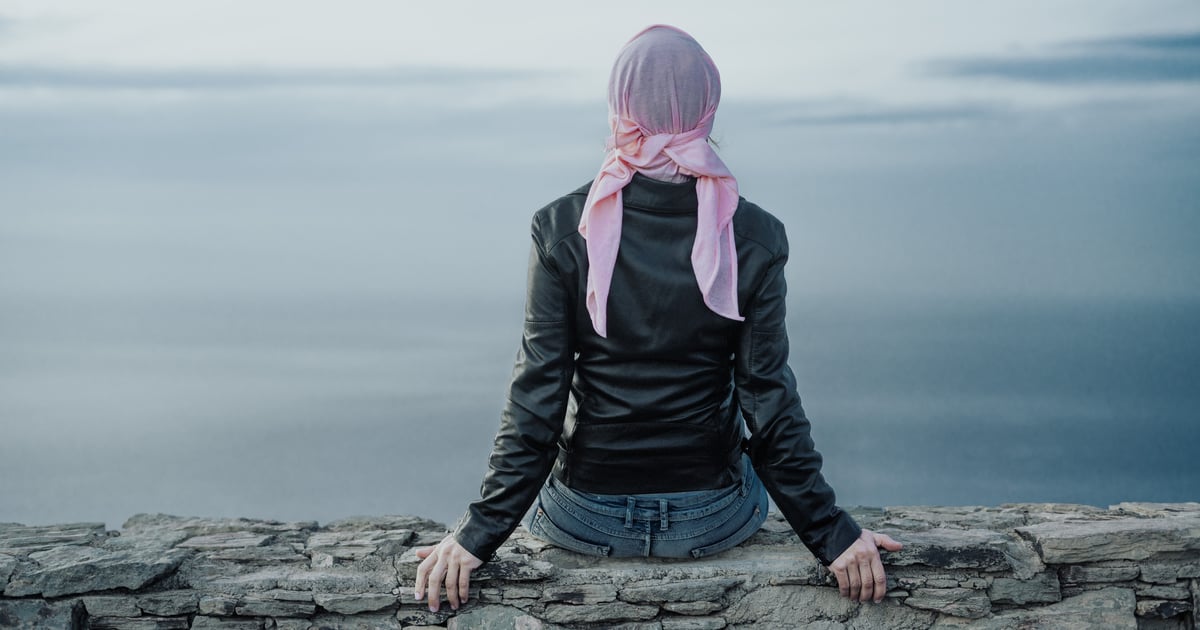
Melly Testa was used to questions — specifically unanswered questions — about their breast. By 2011, the 41-year-old artist had already spent three years navigating doctors, alarming symptoms, and inconclusive tests. But finally, and at the urging of a concerned nurse practitioner, Testa was going to get their answer.
It was back in 2008 that Testa first noticed bloody discharge coming from their right nipple. Doctors were initially concerned, but after testing, found no abnormalities. “I’ve had a reticence of visiting doctors anyway,” remembers Testa. “So to have that doctor say, ‘It’s OK, we don’t understand what this is, but it’s not cancer,’ it was just a relief that I grabbed onto. But, you know, just a few short months later, I couldn’t really grab onto that wish anymore.”
Not long after the initial false negative, in 2009, Testa felt a lump in their right breast. A mammogram yielded no abnormalities, and again, Testa was assured it was nothing to worry about. As a result, Testa says, “I was dismissive of the need for another appointment.” But soon after moving from Arizona to New York City, Testa felt the lump getting larger. They went to a gynecologist, and the nurse practitioner there made Testa an appointment with a breast specialist.
“There’s a saying that cancer doesn’t discriminate, but we know that in the LGBTQ+ community, there are many factors that play into apparent differences in cancer incidence, care, and outcomes that are largely unresearched.”
But after all the back-and-forth and settling in after a big move, Testa wasn’t sure they wanted to pursue the matter any further. “I think I was being purposefully obtuse, not wanting to face more doctors, and was intimidated with the idea of a ‘breast specialist,'” they say. “My breasts were quite large. I didn’t love them, they brought a type of attention that was not suitable to me. I almost ignored my breasts because of this.”
But the nurse practitioner was dogged. When she heard Testa hadn’t followed up with their appointment, she kept calling (and calling and calling) until, finally, Testa picked up. “That appointment got me a diagnosis,” says Testa. “I think of [the nurse practitioner] as my angel.”
After two false negatives, a three-year delay in diagnosis, and assurances to the contrary, Testa finally learned they had breast cancer — and it had already progressed to stage three.
Every year, over 240,000 people are diagnosed with breast cancer in the United States, per the Centers For Disease Control and Prevention (CDC). But not all breast cancer is treated or diagnosed equally. A 2023 study published in JAMA Oncology found that LGBTQ+ patients with breast cancer experienced delays in diagnosis and were at three times greater risk of cancer recurrence than their cis, heterosexual counterparts. For Testa, who is both bisexual and nonbinary, the study’s results reflect their own experiences seeking care.
“There’s a saying that cancer doesn’t discriminate, but we know that in the LGBTQ+ community, there are many factors that play into apparent differences in cancer incidence, care, and outcomes that are largely unresearched,” says surgeon Monique Gary, DO, the medical director of the Grand View Health/Penn Cancer Network Cancer Program. “It’s not uncommon that LGBTQ+ people face greater difficulties in accessing care than their cisgender counterparts and develop a complicated relationship with medical providers.”
These healthcare disparities are caused by both socioeconomic and structural barriers, according to Shawn Reilly, a nonbinary cancer survivor and a project specialist for the National LGBT Cancer Network. Reilly says LGBTQ+ folks have higher rates of poverty, as well as financial and housing insecurity. As a result of this instability, LGBTQ+ people are underinsured, less likely to access preventative care — including cancer screenings — and have lower rates of healthcare utilization, says Reilly. Disadvantage compounds, too, along other marginalities like race, ability, and class.
But it’s not just systemic barriers that prevent people from getting care. After all, according to the JAMA Oncology study, queer patients actively seeking treatment still waited almost double the time for diagnosis. “Providers are often uneducated or miseducated on appropriate screening and treatment protocols that are patient-centered, trauma-informed, and affirming,” says Reilly. This lack of education can be attributed, at least in part, to the huge gaps in research that exist in LGBTQ+ experiences of cancer, from prevention all the way to prognosis. “Lack of diversity in clinical trials also limits the knowledge needed to develop cancer care and treatments that are personalized and effective for LGBTQ+ patients,” says Dr. Gary.
And often, these providers — purposefully or not — end up ostracizing their queer and trans patients. In fact, Dr. Gary says about 70 percent of LGBTQ+ people have reported experiences that damaged their trust in the healthcare system. The result? If people have had or anticipate negative interactions with medical providers, they are much less likely to access care, especially those with intersecting identities, says Amanda Bolderston, cofounder of Queering Cancer, an advocacy network providing research and educational resources for queer people affected by cancer.
In Testa’s case, they choose not to disclose their identity to doctors, a decision they “felt deeply.” But when Testa chose to opt for aesthetic flat closure surgery (AFC) postmastectomy — a surgery which would leave the chest fully flat — they experienced significant pushback from their medical team. “A couple of different times, my care team suggested that I might become gender confused were I not [to] reconstruct my body to breastedness. And for me, that wasn’t an issue, it was sort of offensive for them to make that assumption about my person.” Testa’s insurance was also resistant to the AFC surgery and denied coverage — in part because Testa declined more traditional breast reconstructive surgery and because AFC was not yet recognized as a valid form of reconstruction.
“Aesthetic flat closure queers breast cancer,” says Testa. “In my opinion, choosing to live flat is an example of gender nonconformity within the breast cancer community, as society, doctors, and insurance companies expect ‘women’ to want breast mound replacement surgeries. We aren’t a one-size-fits-all monolith.”
Given Testa’s experiences with both diagnosis and treatment, it’s clear the healthcare system needs an overhaul in two key areas — systemically and interpersonally.
Systemically, healthcare needs to be affordable (or free *cough cough*) for everyone. But healthcare alone isn’t enough, as Reilly says there are co-occurring barriers that many LGBTQ+ people with cancer experience. For example, food and housing insecurity, unequal educational access, and economic instability. As Reilly puts it: “This means opening or supporting affirming healthcare practices in rural areas. This means dismantling the harmful transphobic and homophobic laws that are passing in hostile areas and states.”
Research, too, represents a significant barrier to quality of care. “We need better, more intentional research, made in partnership with LGBTQ+ people, to help better illuminate the disparities that the community faces and to better develop intentional interventions to support our community,” says Reilly. “We need comprehensive, holistic continuity of care across the life span.”
Finally, the medical field needs to reestablish trust with the LGBTQ+ community through professional and culturally informed interpersonal care. “As healthcare providers, we have to do a better job of helping patients feel seen. It is our job to restore the trust between the community in our profession, not the other way around,” says Dr. Gary. “We have to move beyond the golden rule of treating people like we want to be treated, to the platinum rule of treating people as they want to be treated, and partnering with patients to make sure that they understand what we recommend, why we recommend it, and that it truly is in their best interest, especially when it comes to cancer care.”
As for LGBTQ+ people themselves, there are ways to take steps to protect your health and the health of your loved ones. Regular cancer screenings are essential in combating late-stage diagnosis — as is advocating for yourself if something seems off. Bullishness, as Testa puts it, and self-edification are key to getting the care you need. To get started with a screening, the American College of Radiology released a breast cancer screening guide for trans folks here. You can also check out Queer Health Is Power, launched by National LGBT Cancer Network, which provides information on screenings and a list of LGBTQ+-affirming providers.
Organizations like Queering Cancer, the National LGBT Cancer Network, and the National LGBT Cancer Project can help connect you to qualified medical providers, relevant research, support groups, and other resources you’ll need to navigate breast cancer as a queer person.
As for Testa, they say they never would have begun advocacy work if it wasn’t for their delayed diagnosis. Now 54, and cancer-free, Testa is a vocal supporter of aesthetic flat closure surgery, and has worked with Women’s Health, CNN, The Grace Project, and others to raise awareness.
“I really wanted to make a splash and have it known that not everyone chooses breast mound surgeries and that a flat surgical result is just as valid,” they say. “So I think I did a pretty good job at that. I’m happy to say that that aesthetic flat closure is now an entry in the National Institutes of Health’s oncological dictionary of terms.”
Image Source: Flickr / Ken Hedlund
